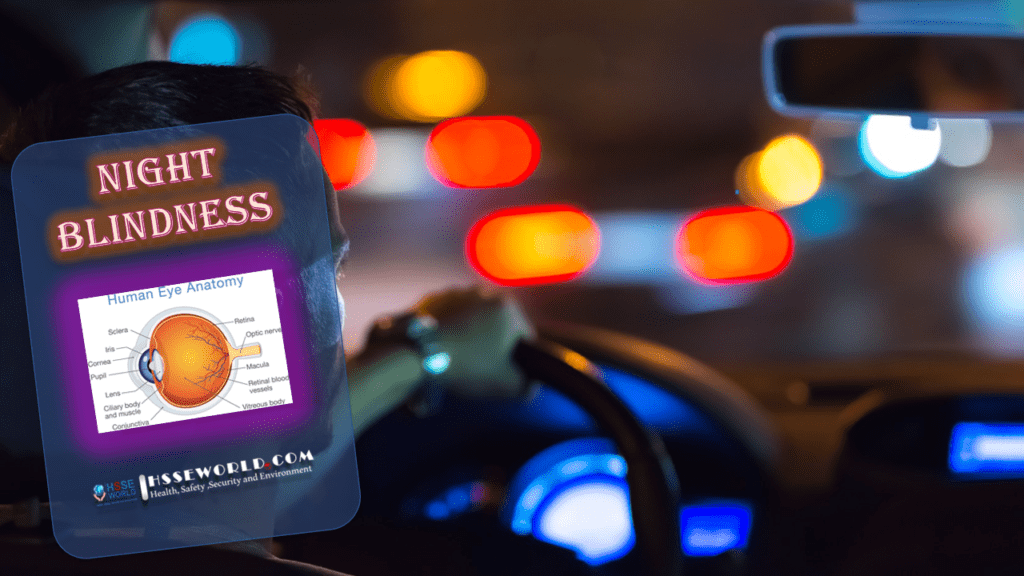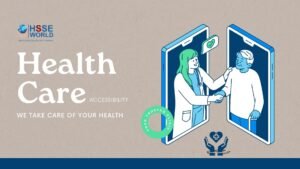Night Blindness Facts
7 min readAbout 30% of jobs require some driving. Workers who drive at night including nearly over-the-road truckers and delivery drivers face a three times greater risk of death than when driving during the day. Why is driving at night so dangerous? One reason is that 90% of a driver’s reaction depends on vision.5 Depth perception, For drivers who suffer from night blindness, or nyctalopia, seeing well on the road at night is even more difficult. Fortunately, prevention and treatment options are available to many. Plus, these practical steps can help employees with night blindness travel easier and more safely at night.
In this article you will be familiar with the following facts :
- What is night blindness?
- What causes night blindness?
- How can night blindness be prevented?
- What can help when traveling at night?
- When should night blindness be treated by a healthcare provider?
Also Read: E-Books: Investigation of Occupational Accidents and Diseases

What is night blindness?
Night blindness is not a disease, but rather the eye’s inability to adapt quickly from light to dark. Human eyes are constantly adjusting to the light. In low or no light, the black pupils in the center of the eye get bigger (dilate) so more light can enter the eye. That light is then received by the retina, the tissue in the back of the eye that houses the cone and rod cells.
Cone cells help people see colors, while rod cells help them see in the dark. Sometimes, the rods get damaged due to a disease, injury, or another condition. This can make it difficult to see at night.
Employees who drive at night may get blinded by a flash of bright lights followed by a stretch of a dark road. Their vision may become impaired during the brief time their eyes are trying to adjust between light and dark. They can lose their contrast sensitivity (the ability to see objects separate from the background) and peripheral vision (the ability to see objects at the edges of their visual field).
What causes night blindness?
A wide range of conditions – from sun exposure to diabetes can cause night blindness including:
Nearsightedness

Nearsightedness, or myopia, is a common eye problem that makes it hard for people to see distant objects. It is also often linked with an inability to quickly adapt from a well-lit to a poorly-lit environment. This eye problem is caused by an eye shape that is too long to allow light to focus correctly on the retina. Usually, nearsightedness can be corrected with eyeglasses, contact lens- es, or surgery. However, in rare cases, a progressive type of degenerative myopia develops, which is the leading cause of legal blindness
Watch : Video: Protecting our sight
Cataracts
As a person ages, proteins and fibers in the eye’s lens can begin to break down, causing vision to become hazy or cloudy. The first symptom of cataracts is often poor night vision. Because cataracts distort the light that comes into the eyes, people may see halos around lights, especially at night. Blurry vision is also common. Often stronger eyeglasses or lens replacement surgery can treat cataract-related vision problems.
Lack of Vitamin A
Vitamin A is found in carrots and leafy vegetables, among other food items. This vitamin helps keep the retina healthy. Most people get enough vitamin A in their diets, but for employees with health issues such as Crohn’s disease or celiac disease, or those who have had gastric bypass surgery, it may be hard to absorb enough nutrients.9 The result may be night vision problems, which can be treated with improved nutrition and vitamin A supplements.
Lack of Zinc
Without zinc, vitamin A does not work as well as it should. Rich sources of zinc include beef, poultry, beans, and nuts. Most people get enough zinc from their food. For those who do not, it can result in night blindness. Many physicians suggest 15 to 30 mg. of zinc per day to support healthy vision.
Sunlight Exposure
Many employees who drive on the job or work outdoors are exposed to long hours in the sun. Sunlight exposure is a major risk factor for cataracts, macular degeneration, corneal sunburns, and other eye diseases. Wearing sunglasses during the day can help prevent eye damage and the loss of vision in no or low light.
Diabetes
Over the years, diabetes (high blood sugar) damages the blood vessels and nerves in the eyes.13 This damage, known as retinopathy, can cause diabetics to not see well in low light. Diabetics should monitor their blood sugar levels frequently and work with their doctors to manage the disease.
Retinitis Pigmentosa
The earliest symptom of this rare genetic disorder is usually a decline in night vision. At this time, there is no specific treatment for retinitis pigmentosa.
Glaucoma
Glaucoma is a general term used to describe a group of eye disorders that damage the optic nerve. It is the most common form of optic nerve damage leading to vision loss.15 Glaucoma medication works by constricting the pupil, which can make it harder to see at night. Treatment options for glaucoma may include prescription eye drops, oral medications, laser treatment, surgery, or a combination of these.
How can night blindness be prevented?
While hereditary factors cannot be prevented, people can control their lifestyles. Encourage employees to follow these tips:
- Eat foods high in vitamin A. Foods such as carrots, cantaloupes, butternut squash, spinach, milk, and eggs can help prevent night blindness.
- Get regular eye exams. Remind employees to see an eye specialist regularly to identify possible eye problems early and begin treatment.
- Wear sunglasses. Encourage all employees who are exposed to sunlight to wear sunglasses to protect their eyes from ultraviolet (UV) rays. Sunglasses should:
- block at least 99% of UV-A and UV-B rays:
- protect the eyes from every angle; and
- filter at least 75% of visible blue light.
- Exercise. Exercise can reduce the risk of eye problems and lower eye pressure and glucose levels. Encourage employees to create an active, healthy lifestyle.
Also Read: Sun & UV radiation Exposure
What can help when traveling at night?
As employees age, their vision tends to gradually become worse, especially at night. Here are some tips to make traveling at night easier:

- Keep the vehicle’s windows, mirrors, and headlights clean. A dirty windshield may not be noticeable during the day, but it can cause glare at night. Dirt and grime can also build up on the headlights, so remind employees to check and clean them regularly. On company vehicles, consider upgrading bulbs and polishing scratched headlight covers.
- Dim the dashboard. Bright lights from the vehicle’s dashboard or instrument panel can distract drivers from the road. Lower the dashboard lights or turn the navigation system to night mode as needed.
- Use the night setting on the rearview mirror. Most review mirrors have settings to reduce the brightness and glare of headlights behind the driver. Check the vehicle’s manual for instructions. When the glare is gone, employees can readjust the mirror to the daytime setting.
- Do not look at oncoming headlights. When oncoming traffic approaches, train employees, to gaze at the right lane markings, the right edge of the pavement, or straight ahead to avoid directly looking at the headlights.
- Reduce driving speeds. One of the safest steps employees who have trouble seeing at night can make is to drive slower and increase their following distance behind the vehicle in front of them.
- Drive within the visual range of the vehicle’s headlights. At night, headlights limit a driver’s view from about 160 feet to 350 feet of the road ahead. Encourage employees to use high beams when possible.
- Wear eyeglasses with an anti-reflective coating. Anti-reflective coatings can help prevent light from bouncing around inside an employee’s eyeglass lenses. For those who wear prescription glasses, encourage them to choose frames with thin sidepieces so their vision is not hindered.
- Expand peripheral vision. Remind employees that they can increase their peripheral vision, which decreases at night, by turning their heads from side to side more frequently.
- Do not apply aftermarket window tinting. Avoid applying dark tinting on company vehicle windows or windshields. It decreases an employee’s ability to see clearly at night.
- Avoid using medication that may alter night vision. Certain classes of drugs are known to cause eye problems. These include diuretics (water pills), antihistamines, antidepressants, drugs that lower cholesterol, beta-blockers, and birth control pills. Encourage employees to monitor medications that may interfere with safe driving.
Also Read: Sleep Deprivation and worker Safety
When should night blindness be treated by a healthcare provider?
It is important to encourage employees to have an annual eye exam to ensure their glasses prescriptions are up-to-date and to screen for potential eye conditions. For those who struggle to see while driving on the job or in a low-lit room, consider scheduling an appointment for them with a healthcare provider right away. Night blindness can be a symptom of a serious disease that can cause work-related injuries. An eye specialist can perform a full eye exam to determine the cause of an employee’s night blindness and may order specialized tests, images, and exams. The healthcare provider may also ask about the patient’s diet, medications, recent injuries, family history of diabetes, and stress levels. From this information, a specialist can determine whether the patient’s night blindness is treatable.
Also read:
Please visit our Safety Resources SAFETY BAG to have many Safety Resources





1 thought on “Night Blindness Facts”